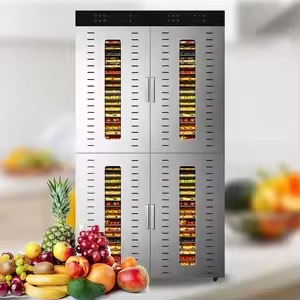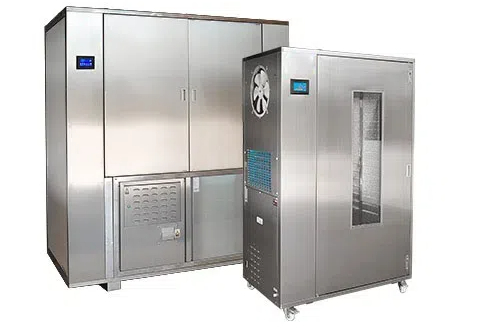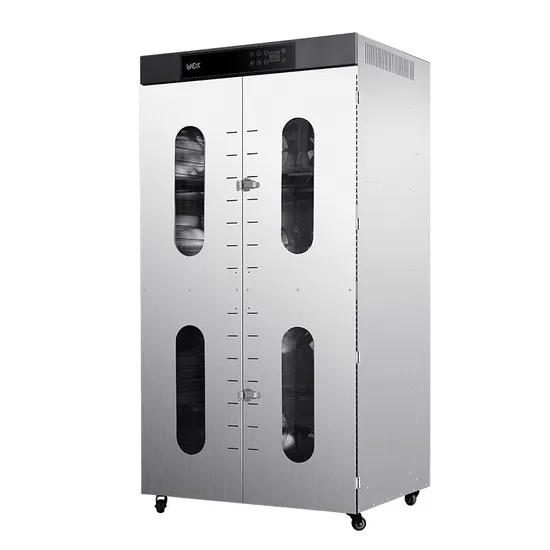
Content Menu
● Introduction
● Understanding Cabinet Type Dehydrators
>> Key Components and Technology
>> The Drying Process
● Advantages of Cabinet Type Dehydrators
>> Precise Control
>> Large Capacity
>> Energy Efficiency
>> Versatility
>> Protection from Contaminants
>> Other Features
● Applications of Cabinet Type Dehydrators
● Case Studies: Real-World Applications
● Maintaining Your Cabinet Type Dehydrator
>> Cleaning
>> Inspection
>> Storage
>> Descaling
● Innovations in Cabinet Type Dehydrators
>> Smart Dehydrators
>> Improved Energy Efficiency
>> Advanced Control Systems
>> Hybrid Dehydrators
● Conclusion
● FAQ
>> 1. What types of food can be dried in a cabinet dehydrator?
>> 2. How do cabinet dehydrators ensure uniform drying?
>> 3. Are cabinet dehydrators energy-efficient?
>> 4. How often should I clean my cabinet dehydrator?
>> 5. What maintenance is required for cabinet dehydrators?
● Citations:
Introduction
Food preservation is an age-old practice, essential for extending the shelf life of perishable goods and ensuring food security. Among the various methods available, dehydration stands out as a simple, effective, and versatile technique. Cabinet type dehydrators, in particular, have gained prominence for their efficiency, precise control, and suitability for both small-scale and commercial operations. This article explores the technology behind cabinet type dehydrators, their benefits, maintenance, the various applications and the latest innovations driving their evolution.

Understanding Cabinet Type Dehydrators
Cabinet type dehydrators are designed to remove moisture from food items by circulating warm, dry air within an enclosed chamber. This process inhibits the growth of microorganisms and enzymes that cause spoilage, thereby preserving the food.
Key Components and Technology
1. Digital Control Systems: Modern cabinet dehydrators are equipped with digital control systems that allow for precise adjustment and monitoring of temperature, humidity, and airflow. These systems ensure uniform drying, which is crucial for maintaining the quality and consistency of the dried products. Sophisticated algorithms optimize the drying process, adjusting parameters in real-time based on sensor feedback. This ensures that the food is dried to the desired moisture content, preserving its flavor, texture, and nutritional value.
2. Heating Elements: The heating elements generate the warm air necessary for drying. Efficient heating systems and insulation minimize energy consumption. The type of heating element used can vary, with some models employing electric resistance coils, while others use infrared or gas-powered heating. The choice of heating element depends on factors such as energy efficiency, heating speed, and temperature control.
3. Air Circulation: A fan or blower circulates air throughout the cabinet, ensuring even distribution of heat and moisture removal. The design of the air circulation system is critical to ensure uniform drying. Some dehydrators use multiple fans or strategically placed baffles to optimize airflow and prevent hot spots. The speed and direction of the airflow can also be adjusted to suit different types of food.
4. Trays: Food items are placed on trays within the cabinet, allowing for maximum exposure to the circulating air. The trays are designed to maximize airflow around the food items, ensuring even drying. The material of the trays can also affect the drying process, with stainless steel being a popular choice for its durability, hygiene, and heat conductivity.
The Drying Process
The drying process in a cabinet dehydrator involves a combination of controlled temperature, humidity, and airflow. The circulating air removes moisture evenly from all surfaces of the food items. This uniform drying is crucial for maintaining the quality and consistency of the dried products. The optimal temperature, humidity, and airflow settings vary depending on the type of food being dried. Some foods, such as fruits, require lower temperatures and longer drying times to preserve their sweetness and flavor. Other foods, such as meats, require higher temperatures to prevent bacterial growth and ensure food safety.

Advantages of Cabinet Type Dehydrators
Cabinet type dehydrators offer several advantages that make them a preferred choice for food preservation.
Precise Control
These dehydrators provide precise control over temperature and humidity, ensuring even drying. This is particularly important for delicate items that require specific conditions to maintain their quality. The ability to precisely control the drying parameters allows for greater flexibility in drying different types of food. For example, herbs can be dried at lower temperatures to preserve their volatile oils and aromatic compounds. Fruits can be dried at higher temperatures to speed up the process and prevent browning.
Large Capacity
Cabinet dehydrators are designed to handle capacities ranging from 100kg to 1000kg, making them suitable for small-scale operations. This makes them a cost-effective solution for businesses that need to process large quantities of food. The large capacity of cabinet dehydrators also makes them suitable for commercial applications, such as drying fruits, vegetables, and meats for sale in grocery stores and specialty food shops.
Energy Efficiency
These dehydrators are designed to minimize energy consumption through insulation and efficient heating systems. Many models also include energy-saving features like automatic shut-off timers and adjustable temperature settings. Energy efficiency not only reduces operating costs but also minimizes environmental impact. The use of high-quality insulation materials, such as rock wool or polyurethane foam, helps to reduce heat loss and improve energy efficiency. The design of the air circulation system can also affect energy efficiency, with some models using variable-speed fans to reduce energy consumption during periods of low demand.
Versatility
Cabinet dehydrators can dry a wide range of foods, including fruits, vegetables, meats, herbs, and snack items. You can adjust the temperature and humidity settings based on the specific type of food. This versatility allows businesses to process various products with a single machine. The ability to dry different types of food in the same dehydrator reduces the need for multiple machines and saves space.
Protection from Contaminants
The enclosed design protects food from external contaminants. This ensures that the dried food products are safe and of high quality. The use of air filters and UV sterilization systems can further enhance the protection against contaminants.
Other Features
Some cabinet type dehydrators are designed for portability and can be directly loaded into shipping containers. This feature is particularly useful for businesses that need to move their equipment frequently. Additional features may include automatic humidity control, which helps to maintain optimal drying conditions, and integrated cleaning systems, which simplify the cleaning process.
Applications of Cabinet Type Dehydrators
Cabinet dehydrators can dry a wide range of foods, including fruits, vegetables, meats, herbs, and snack items. You can adjust the temperature and humidity settings based on the specific type of food. This versatility makes them a valuable asset for various food processing needs.
- Fruits and Vegetables: Drying fruits and vegetables allows for long-term storage and preservation of nutrients. Common applications include drying apples, bananas, berries, carrots, and tomatoes. The dried products can be used in snacks, cereals, soups, and other food items.
- Flowers and Herbs: Cabinet dehydrators can also be used to dry flowers and herbs for medicinal, cosmetic, and culinary purposes. Drying herbs preserves their flavor and aroma, making them a valuable addition to spice blends and seasonings.
- Meat and Pet Treats: Drying meat and pet treats is another common application of cabinet dehydrators. Jerky, biltong, and other dried meat products are popular snacks and can be made safely and efficiently using cabinet dehydrators. Pet treats, such as dried chicken or beef, can also be produced using this method.
- Spices and Nuts: Spices and nuts can be dried to remove moisture and enhance their flavor. Cabinet dehydrators provide a controlled environment for drying these products, ensuring that they retain their quality and aroma.
- Tea and Seafood: Cabinet dehydrators can also be used to dry tea leaves and seafood. Drying tea leaves is an essential step in the production of various types of tea. Drying seafood, such as fish and shrimp, allows for long-term storage and transportation.
- Ready to Eat Industry: Dehydrated ingredients and snacks are essential to the Ready to Eat Industry. Cabinet dehydrators provides an efficient and consistent way to produce dehydrated ingredients and snacks.
- Biofertilizer & Pharmaceutical Industry: Cabinet dehydrators play a critical role in producing biofertilizers and certain pharmaceutical products. Drying biological materials in a controlled environment maintains the active components and ensures product efficacy.
Case Studies: Real-World Applications
To further illustrate the effectiveness and versatility of cabinet-type dehydrators, let's consider a few case studies:
- Case Study 1: Small-Scale Fruit Farm: A small-scale fruit farm in California uses a cabinet dehydrator to process excess fruit that would otherwise go to waste. By drying the fruit, the farm can extend its shelf life and sell it as a value-added product in local markets. This has significantly increased the farm's revenue and reduced food waste.
- Case Study 2: Herbal Tea Producer: An herbal tea producer in Oregon uses a cabinet dehydrator to dry herbs for their tea blends. The precise temperature control of the dehydrator ensures that the herbs retain their flavor and aroma, resulting in high-quality tea products.
- Case Study 3: Pet Food Manufacturer: A pet food manufacturer in Texas uses a cabinet dehydrator to produce dried meat treats for dogs and cats. The dehydrator allows the manufacturer to produce large quantities of treats quickly and efficiently, meeting the growing demand for natural and healthy pet food options.
- Case Study 4: Biofertilizer Production: A company in China uses cabinet dehydrators to dry microbial cultures used in biofertilizers. The controlled drying process ensures that the microorganisms remain viable and effective, resulting in high-quality biofertilizer products.
Maintaining Your Cabinet Type Dehydrator
Regular maintenance is essential to ensure the longevity and consistent performance of cabinet type dehydrators.
Cleaning
Clean the dehydrator after each use to prevent buildup. Remove food debris, wash the shelves, and wipe down the interior with a damp cloth. Use a mild detergent and warm water to clean the shelves and interior surfaces. Avoid using abrasive cleaners or scouring pads, as these can damage the surfaces.
Inspection
Regularly inspect the heating elements and blower. Check for signs of damage or wear and replace components as needed. Look for cracks, corrosion, or other signs of damage. Also, check the blower for proper operation and ensure that it is free of debris.
Storage
Store the dehydrator in a dry place. Protect it from dust and moisture to prevent corrosion and other damage. Cover the dehydrator with a dust cover or plastic sheet to protect it from dust and dirt.
Descaling
Periodically descale the heating element to remove mineral buildup, which can reduce its efficiency. Use a descaling solution specifically designed for food processing equipment. Follow the manufacturer's instructions for descaling.
Innovations in Cabinet Type Dehydrators
Advancements in technology have led to significant improvements in cabinet type dehydrators, offering even greater efficiency, control, and usability.
Smart Dehydrators
Incorporating smart technology, such as Wi-Fi connectivity and mobile app control, allows users to monitor and adjust the drying process remotely. This enables users to optimize the drying process and track the progress of their food items from anywhere with an internet connection.
Improved Energy Efficiency
Manufacturers are focusing on developing more energy-efficient dehydrators, using advanced insulation materials and heating systems to reduce energy consumption. This reduces operating costs and minimizes the environmental impact of food preservation.
Advanced Control Systems
New control systems offer even greater precision and flexibility, allowing users to fine-tune the drying process to specific types of food. This results in higher-quality dried products with improved flavor, texture, and nutritional value.
Hybrid Dehydrators
Combining cabinet dehydrators with other drying technologies, such as freeze-drying, can create hybrid systems that offer the best of both worlds. This allows for the preservation of even more delicate and sensitive food items.
Conclusion
Cabinet type dehydrators are an efficient solution for food preservation, providing precise control, energy efficiency, and versatility. They are suitable for a wide range of applications, from small-scale operations to commercial food processing. Regular maintenance ensures their longevity and consistent performance. With advancements in technology, modern cabinet dehydrators offer even greater efficiency, control, and usability.

FAQ
1. What types of food can be dried in a cabinet dehydrator?
Cabinet dehydrators can dry a wide range of foods, including fruits, vegetables, meats, herbs, and snack items. You can adjust the temperature and humidity settings based on the specific type of food.
2. How do cabinet dehydrators ensure uniform drying?
Cabinet type dehydrators use a combination of controlled temperature, humidity, and airflow to ensure that all food items are dried uniformly. The circulating air removes moisture evenly from all surfaces.
3. Are cabinet dehydrators energy-efficient?
Yes, cabinet type dehydrators are designed to minimize energy consumption. They have insulation and efficient heating systems. Look for models with energy-saving features like automatic shut-off timers and adjustable temperature settings.
4. How often should I clean my cabinet dehydrator?
It is recommended to clean the dehydrator after each use to prevent buildup. Remove food debris, wash the shelves, and wipe down the interior with a damp cloth.
5. What maintenance is required for cabinet dehydrators?
Regular maintenance includes cleaning the dehydrator after each use, inspecting the heating elements and blower regularly, storing it in a dry place, and periodically descaling the heating element to remove mineral buildup.
Citations:
[1] https://www.dryeratech.com/understanding-the-technology-behind-cabinet-type-dehydrators.html
[2] https://patents.google.com/patent/CN110207480A/zh
[3] https://www.dryeratech.com/the-science-behind-cabinet-type-dehydrators.html
[4] https://patents.google.com/patent/CN201919616U/zh
[5] https://drybox.in/cabinet-type-dehydrator/
[6] https://patents.google.com/patent/CN1110593C/zh
[7] https://fs-wave.en.made-in-china.com/product/RAtYBWFbAIcw/China-Advanced-Food-Dehydrator-Cabinet-Precision-Adjustable-Temperature-Range-Dryercommercial-Grade-Food-Dryer-Equipment-Industrial-Scale-Food-Dehydrator.html
[8] https://patents.google.com/patent/CN203928604U/zh











